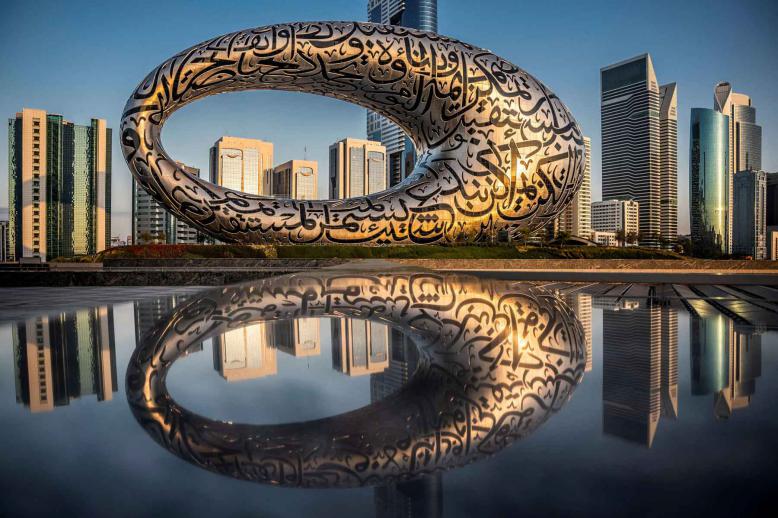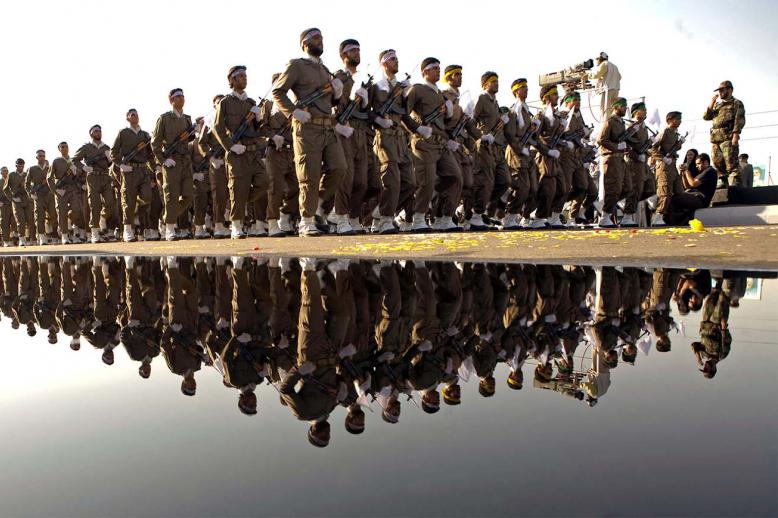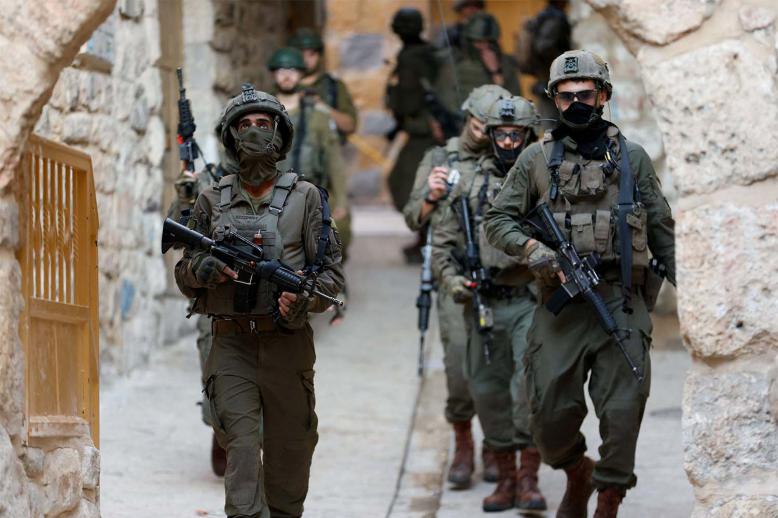Iran’s ‘dangerous game’ with Israel in Syria
BEIRUT — A brooding and brittle calm has settled over the Golan Heights of southern Syria after weeks of clashes between Israel and Iran-linked forces that produced the heaviest exchanges since the 1973 Middle East war.
There are concerns that this uneasy quiet on an increasingly sensitive border will be broken by a looming flare-up in the Syrian war in which Hezbollah and Tehran-controlled Shia militias are expected to begin a major push to retake control of rebel-held territory in southern Syria that borders Israel and Jordan.
Any regime offensive would involve Hezbollah, Iran’s prize proxy force, and militias made up of Shias from as far afield as Pakistan and Afghanistan.
If the Iranians extend their control of southern Syria, Israel might feel it necessary to retaliate in force to any extension of Tehran’s already long arm on the Jewish state’s tense northern frontier.
There is little question about the extent of Iran’s expanding military network in Syria or Iran’s long-term objective of locking Syria in its ambitious embrace of becoming the region’s superpower.
US Army General Joseph Votel, who heads the US Central Command that covers the Middle East, warned in February that the quality and quantity of missiles Iran is supplying to groups it backs in Syria is increasing.
In the recent military exchanges, the Iranians have made no attempt to target Israeli civilians, a red line that could trigger all-out conflict, while the Israelis have restricted themselves to hammering Iran’s military infrastructure in southern Syria.
Even so, many fear a major escalation is brewing.
“Israel and Iran are on a collision course,” warned Dennis Ross, who has been involved with US policy in the Middle East for two decades. “Iran is determined to embed itself in Syria and Israel is just as determined to ensure that Iran cannot create a presence in Syria similar to the one it created in Lebanon…
“Something has to give and, at this point, it seems only a matter of time before a war starts,” Ross wrote in an analysis for the Washington Institute for Near East Policy.
Hezbollah was founded with Iranian support following the Israeli invasion of Lebanon in June 1982, empowering long-downtrodden Shias, who comprise the largest single sect in Lebanon. Its alliance with Syria, Iran’s Arab ally since the 1970s, has made it the most powerful non-state actor in the region with better weaponry than some Arab armies.
It has fought Israel for more than 30 years and become its implacable enemy.
When the Syrian war erupted in March 2011, Hezbollah, at Iran’s insistence, rallied behind Syrian President Bashar Assad’s regime and has been instrumental — along with Iranian troops and treasure and Russian air power — in saving Assad from being overthrown by Arab and US-backed forces.
Seven years on, with Assad secure and in control of about 60% of Syria, the Party of God, again at Tehran’s behest, has shifted strategy to establish a permanent and commanding military presence in Syria to step up Iran´s confrontation with Israel.
Since the 2008 assassination of Hezbollah military leader Imad Mughniyeh by American and Israeli intelligence, the Islamic Revolutionary Guard Corps (IRGC) has increasingly consolidated control over the organisation and is using it as an arm of the IRGC to advance Iran’s strategic ambitions in the Levant.
Tehran’s pressing need now is to first ensure Hezbollah’s long-term control of Lebanon, politically as well as militarily.
The success of the party and its political allies in securing most of the seats in Lebanon’s 128-member parliament in May has given it a legitimacy it had long sought and marks a major gain for Tehran’s regional ambitions.
“As Syria becomes the main potential venue of Iranian-Israeli confrontation, Tehran seems to be tasking Hezbollah with establishing fuller control of Lebanon, a vital forward base for the Islamic Republic,” the Washington Institute observed in a June 5 analysis co-written by Lebanese analyst Hanin Ghaddar, a long-time opponent of Hezbollah.
“Hezbollah has accumulated more than 100,000 rockets and missiles over the years and knows how to use them. It is capable of firing 1,200 of them a day and can accurately target almost every major population centre in a strategic location in Israel.
“In this sense, Hezbollah is Iran’s strongest foreign pawn to play against Israel — yet also its last resort. The group’s hold over Lebanon cannot be sacrificed in an open confrontation with Israel at this point…
“The group is unlikely to be used directly until Iran feels it needs to send a strong message to Israel or launch a full-fledged war.”
Tehran’s consolidation in the Levant was deepened by Iran’s drive to establish a strategic land bridge through Shia-majority Iraq to Syria along which it could funnel arms and troops to confront Israel.
However, observed Israeli analyst Jonathan Spyer: “Iran has an interest in keeping what it’s good at and what it is good at is developing paramilitary proxy political-military organisations.
“This is the key to its success in Lebanon, Syria, Iraq and Yemen. What it is much less good at is conventional warfare, particularly in the air.”
The combat squadrons of Iran’s air force, denied since the 1979 revolution of acquiring updated aircraft and even spare parts, are still equipped with 1970s-era jets such as the US F-4 Phantom and F-14 Tomcat and more capable Russian MiG-29s.
Iran does possess a growing ballistic missile force increasingly capable of reaching Israeli urban centres but to employ that firepower would likely invite devastating second-strike retaliation by Israel and the Islamic Republic’s anti-missile defences are far less effective than Israel’s.
For the time being, Iran’s ability to hit Israel where it hurts — its population centres — is extremely limited because of military and diplomatic constraints.
Increased attacks on Israeli military targets seem to be the only viable option for the Iranians if they wish to press on with establishing permanent military bases, including missile launch sites in and around the Golan Heights.
This, Spyer observed in a May 11 analysis for the US-based Middle East Forum, “means that Iran may well prefer to absorb Israeli strikes” against its considerable forces in Syria, “carrying out a token retaliation for form’s sake.”
The Iranians, he reasoned, would calculate that it is in their interest to quietly build their strength in Syria, while putting up with periodic Israeli disruptions of their arrangements.
“Since the Iranians may well be engaged, as in Lebanon and Iraq, in a project concerned with the long-term transformation of these countries into clients/puppets of the Islamic Republic, the immediate settling of scores may not be deemed of paramount urgency,” Spyer wrote.
That theory is buttressed by the growing internal unrest inside Iran over a worsening economic crisis, with the national currency going through the floor.
Millions of long-suffering Iranians are staging protest rallies demanding that funds being spent on the regime’s ambitions to become the region’s dominant power should be used to support the economy. Even reformist President Hassan Rohani has complained about the costly war effort in Syria.
However, the hardliners, dominated by IRGC commanders, appear to have the ear of Iranian Supreme Leader Ayatollah Ali Khamenei. They continue to direct military operations, using al-Quds Force and Shia proxies, in Syria, Yemen and Iraq.
But a war against Israel, the Middle East’s strongest military power, is a far more dangerous game.
Ed Blanche is a regular contributor to The Arab Weekly. He has covered Middle Eastern affairs since 1967.
Copyright ©2018 The Arab Weekly







